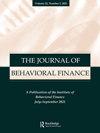买卖期权差异的决定因素:Kospi 200指数期权
IF 1.7
3区 经济学
Q3 BUSINESS, FINANCE
引用次数: 2
摘要
许多研究发现,传统的期权定价模型在实践中并不适用。隐含波动率微笑就是一个例子。在本研究中,我们研究了韩国KOSPI 200指数期权(世界上交易最活跃的衍生产品之一)的现货价格与看跌期权平价所隐含的价格的偏差。在不同的金钱类别中,从“有钱”到“没钱”的选择,偏差都是显著的和有经济意义的。KOSPI 200指数期权的看跌期权差异的决定因素包括过去的现货收益时刻、认知偏差、之前的期权交易量相对于现货交易量。我们发现,在股市极度低迷时期后,更有可能出现定价错误,这意味着当投资者更有可能防范极端损失时,对看跌期权的需求相对于看涨期权增加。我们还表明,由于KOSPI 200指数期权交易者的过度反应,而不是期权价格中包含的信息,看跌期权差价率对未来现货回报具有预测能力。本文章由计算机程序翻译,如有差异,请以英文原文为准。
Determinants of Put-Call Disparity: Kospi 200 Index Options
Abstract Many studies find that traditional option pricing models fail to work in practice. The implied volatility smile is one example. In this study, we examine deviations of spot prices from prices implied by put-call parity for Korean KOSPI 200 index options, one of the most actively traded derivative products in the world. Deviations are significant and economically meaningful across different moneyness categories spanning deep-in-the-money to deep-out-of-the-money options. Determinants of put-call disparities for the KOSPI 200 index options include past spot return moments, cognitive biases, and prior option trading volume relative to spot trading volume. We show mispricing is more likely to occur after periods of extreme downturns in the stock market, implying demand for put options increases relative to call options when investors become more likely to insure against extreme loss. We also show that put-call disparity rates have predictive power for future spot returns due to overreaction of KOSPI 200 index option traders, rather than to information contained in option prices.
求助全文
通过发布文献求助,成功后即可免费获取论文全文。
去求助
来源期刊

Journal of Behavioral Finance
Multiple-
CiteScore
4.60
自引率
10.50%
发文量
34
期刊介绍:
In Journal of Behavioral Finance , leaders in many fields are brought together to address the implications of current work on individual and group emotion, cognition, and action for the behavior of investment markets. They include specialists in personality, social, and clinical psychology; psychiatry; organizational behavior; accounting; marketing; sociology; anthropology; behavioral economics; finance; and the multidisciplinary study of judgment and decision making. The journal will foster debate among groups who have keen insights into the behavioral patterns of markets but have not historically published in the more traditional financial and economic journals. Further, it will stimulate new interdisciplinary research and theory that will build a body of knowledge about the psychological influences on investment market fluctuations. The most obvious benefit will be a new understanding of investment markets that can greatly improve investment decision making. Another benefit will be the opportunity for behavioral scientists to expand the scope of their studies via the use of the enormous databases that document behavior in investment markets.
 求助内容:
求助内容: 应助结果提醒方式:
应助结果提醒方式:


